
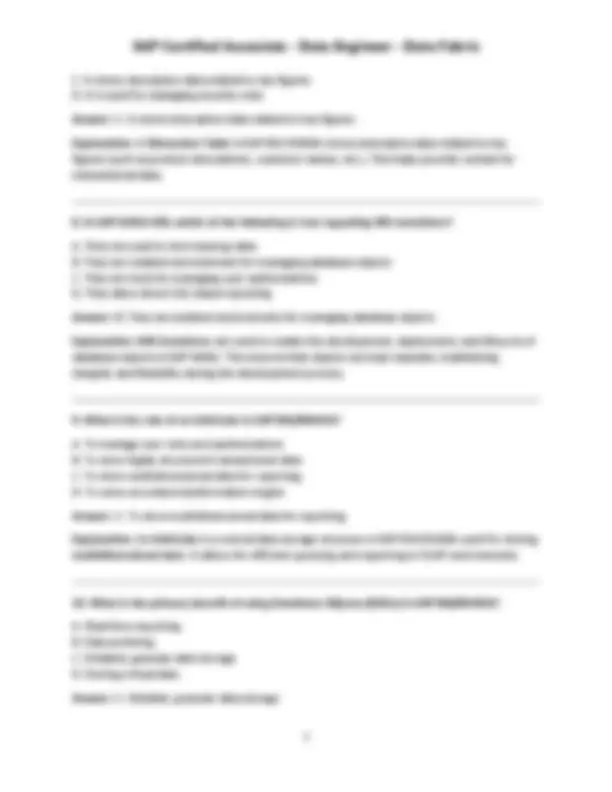
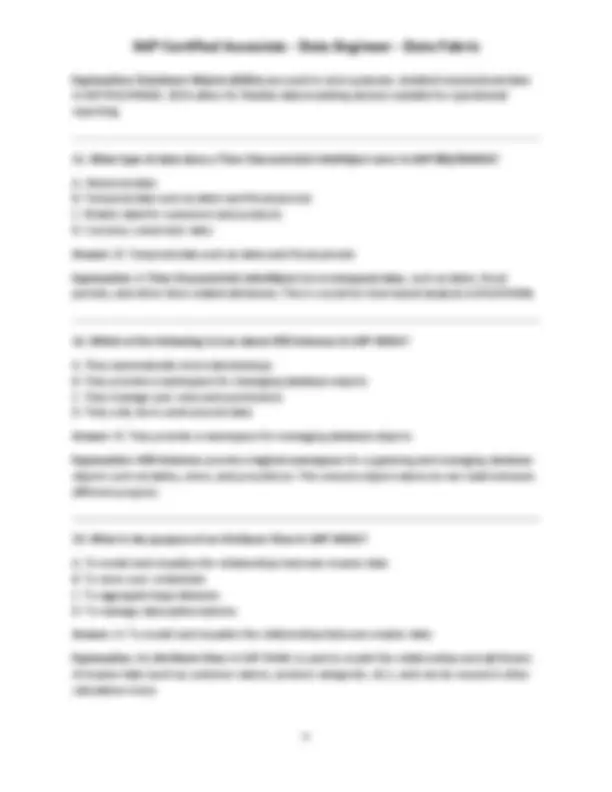
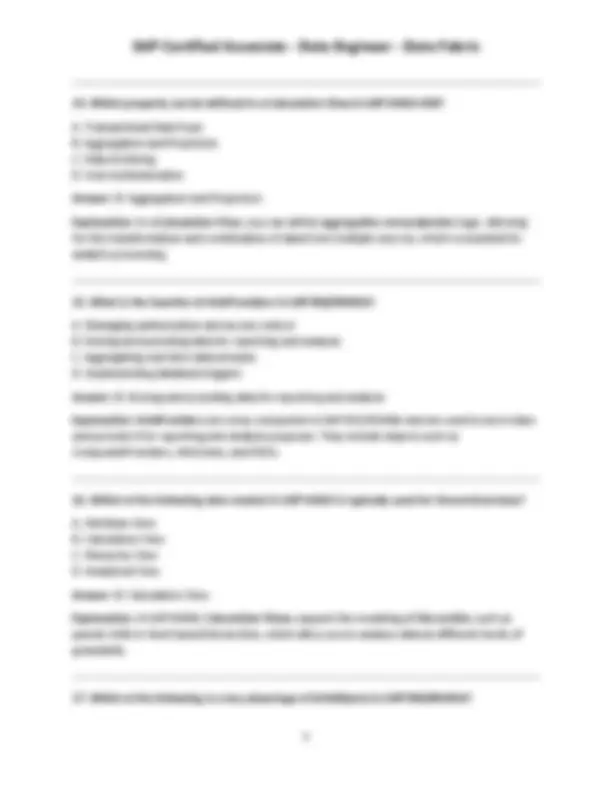
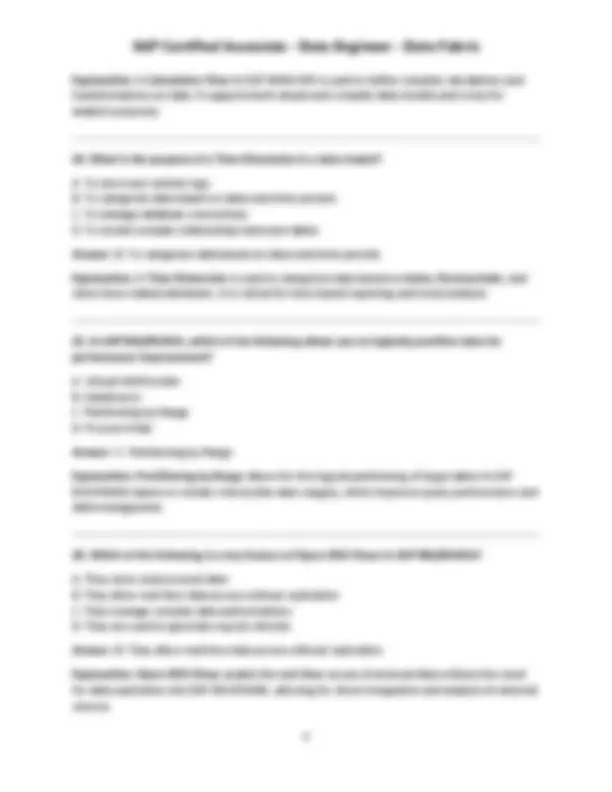
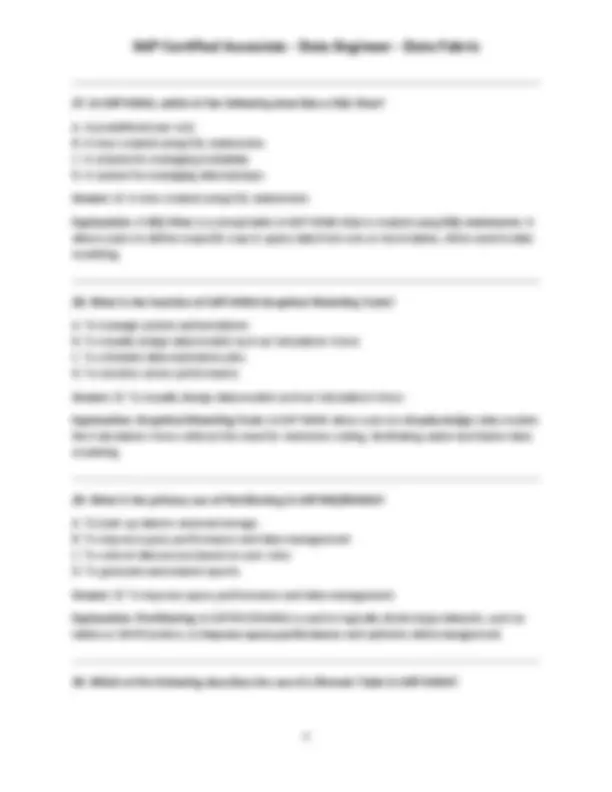
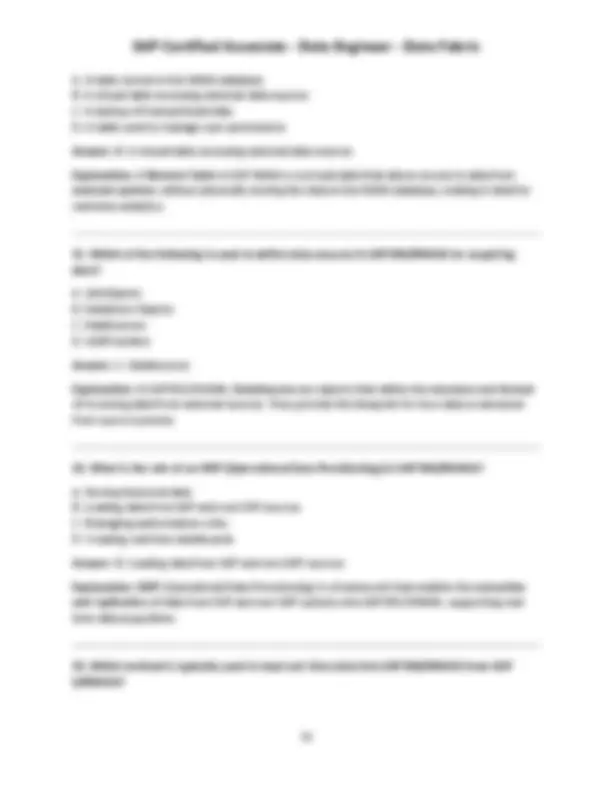
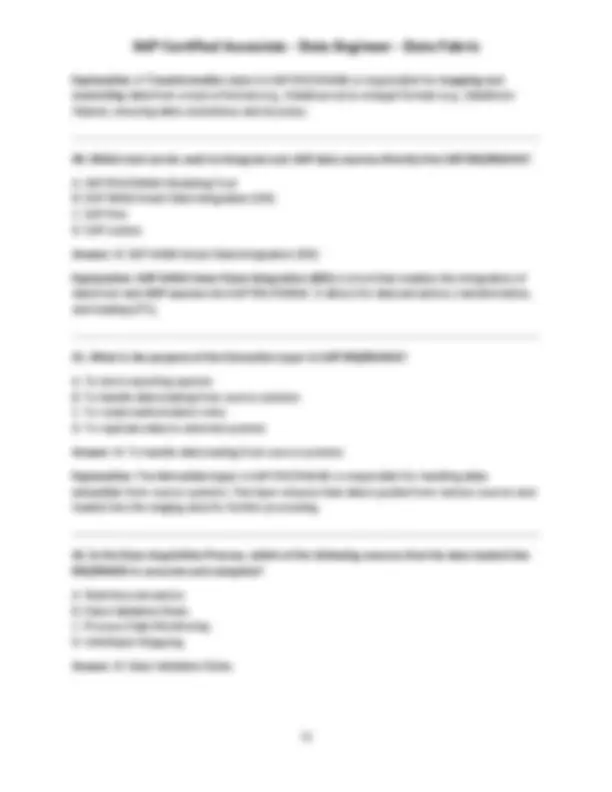
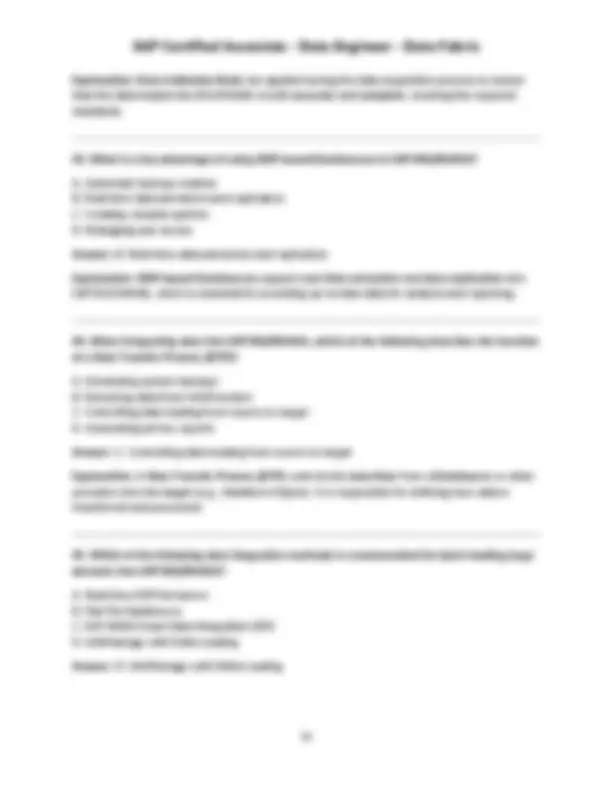
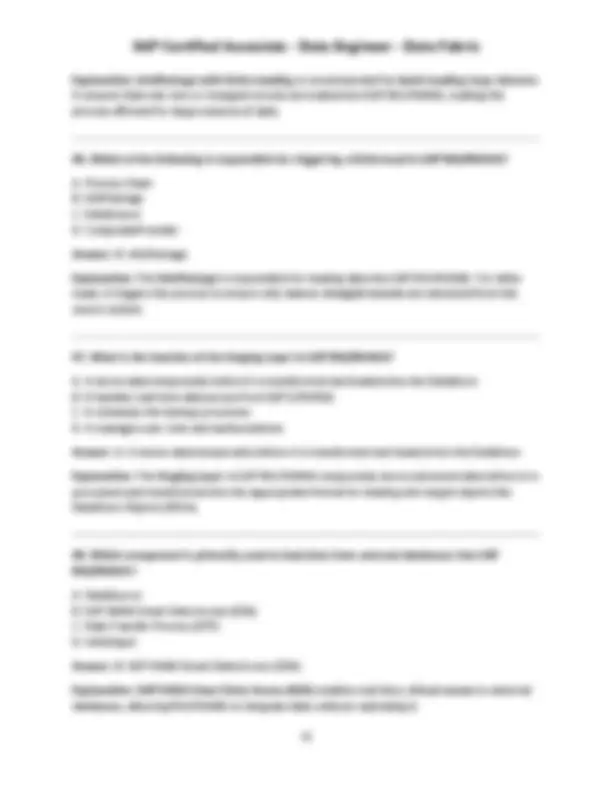
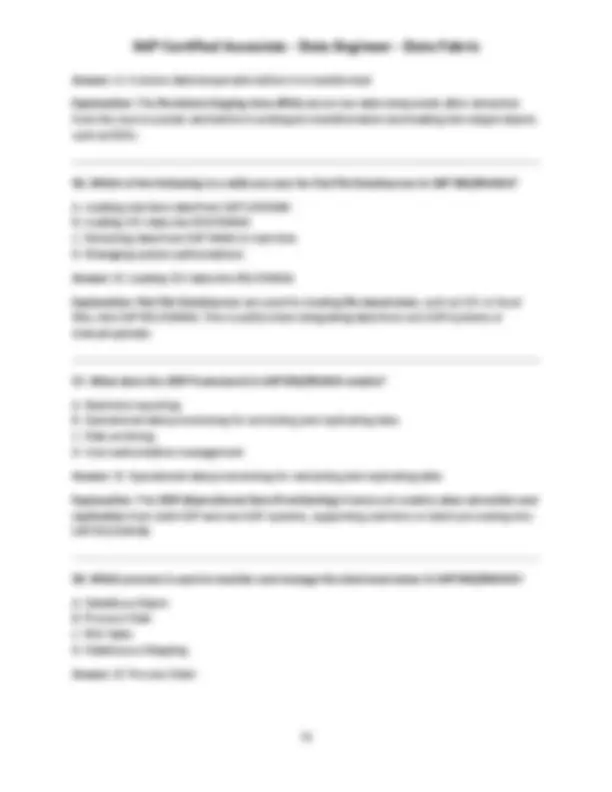
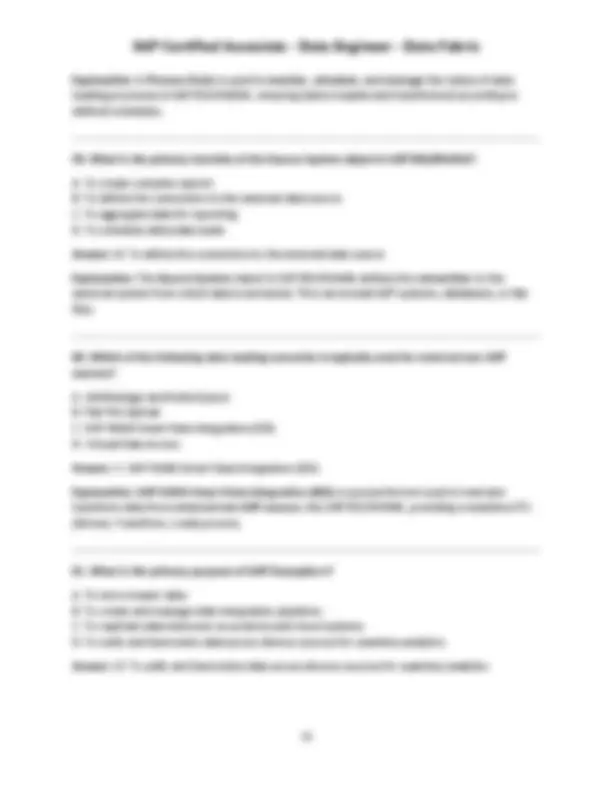
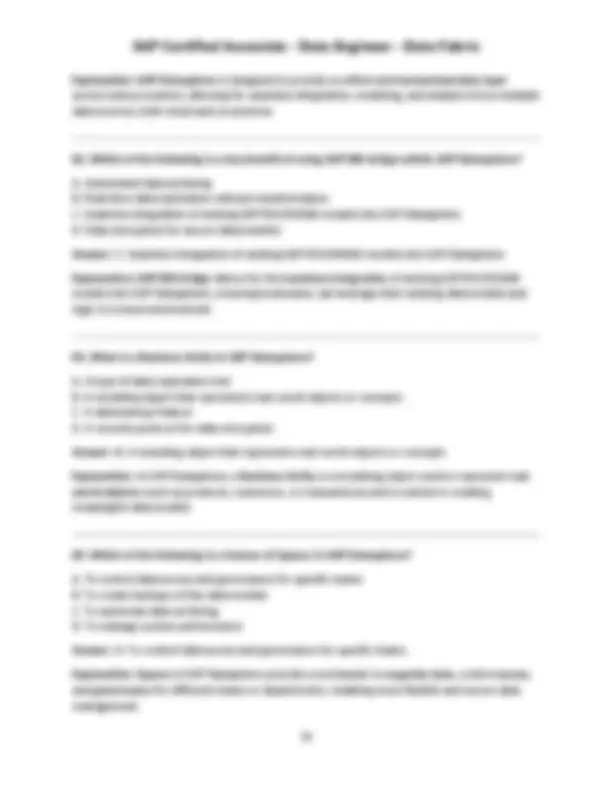

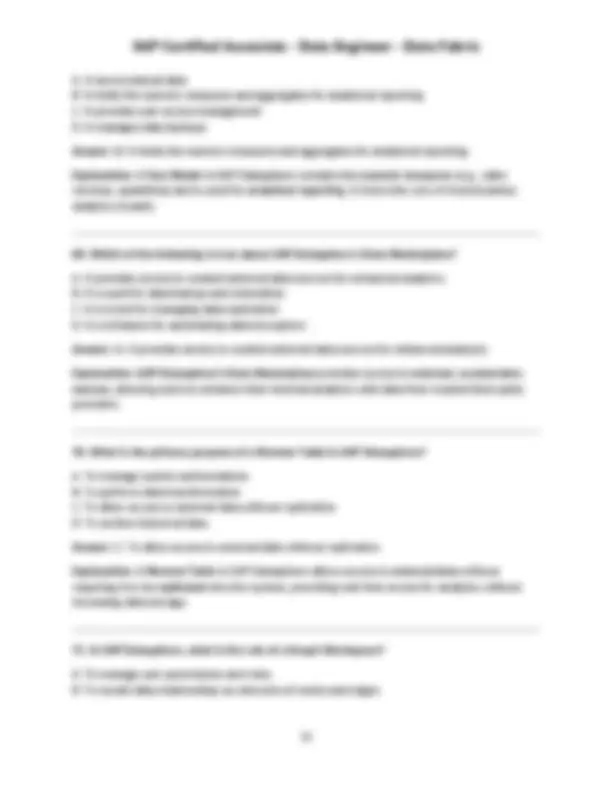
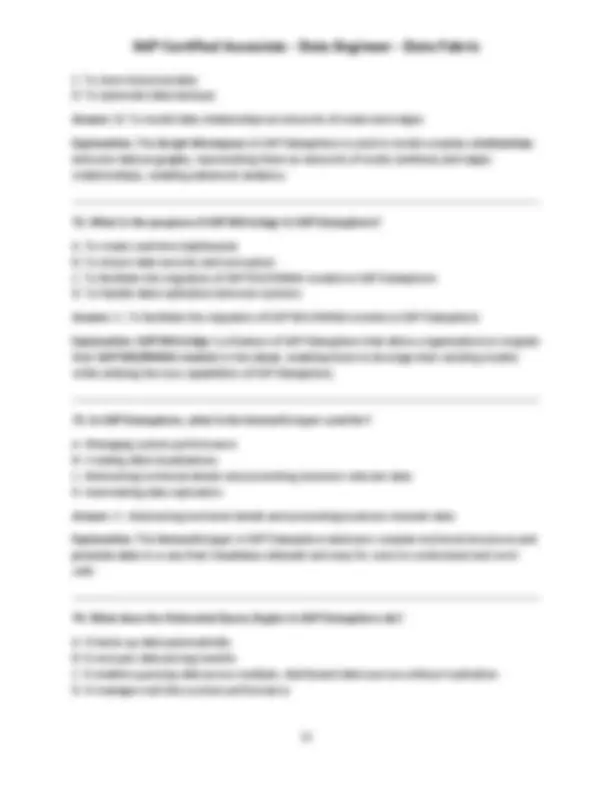
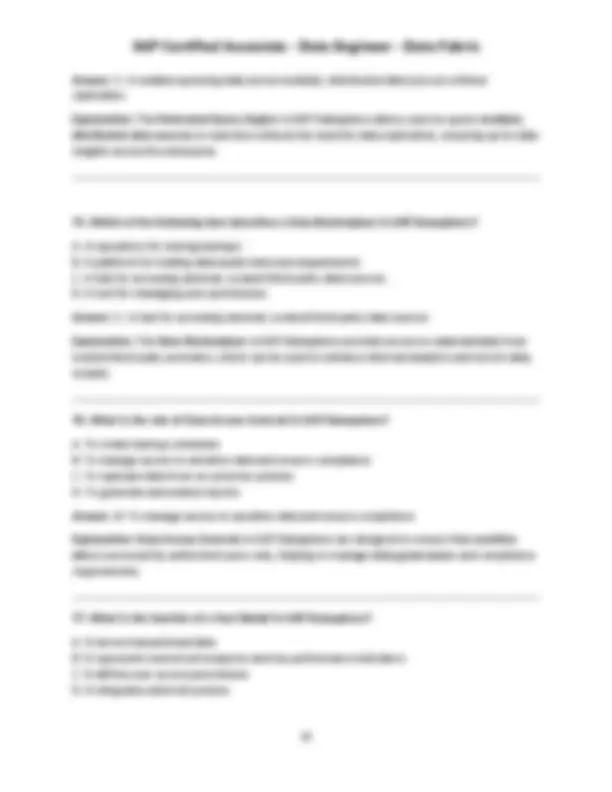
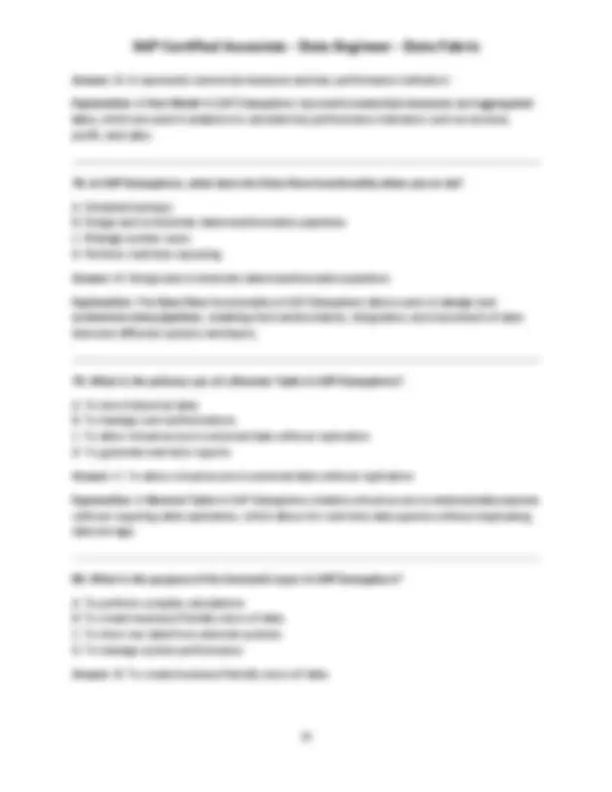
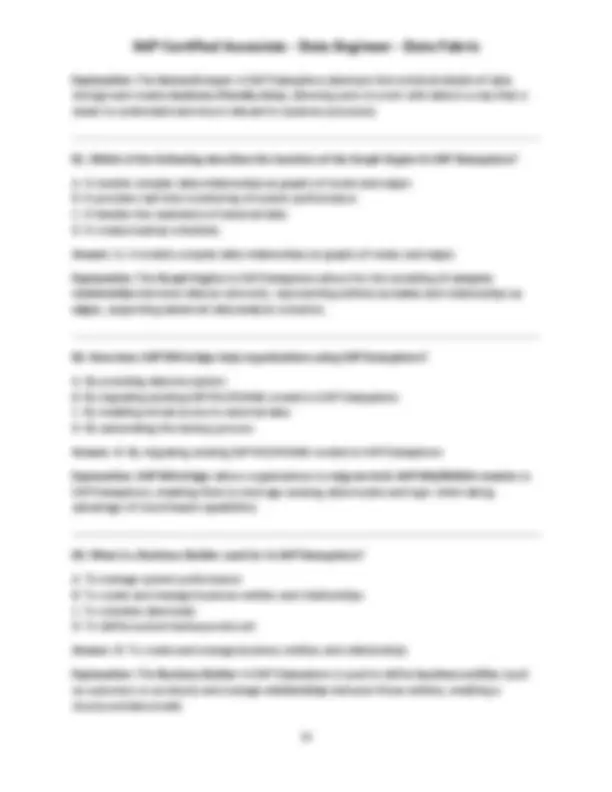
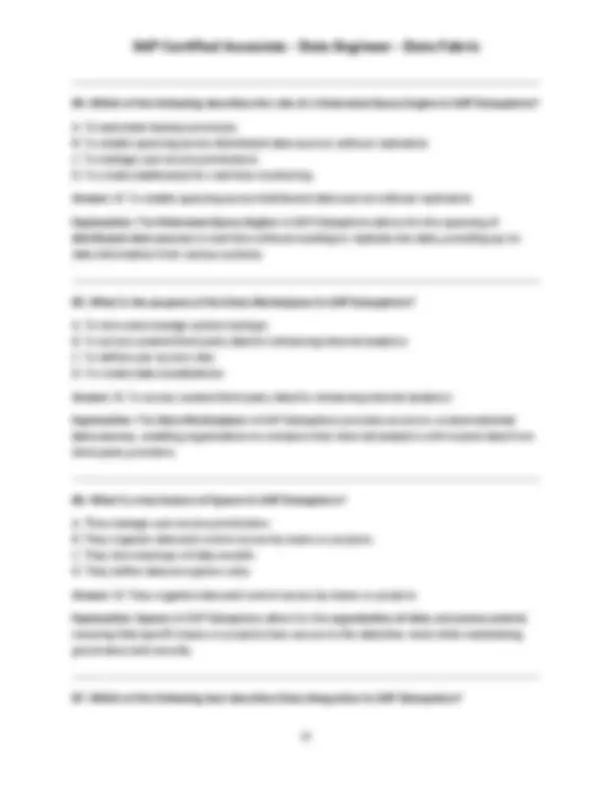
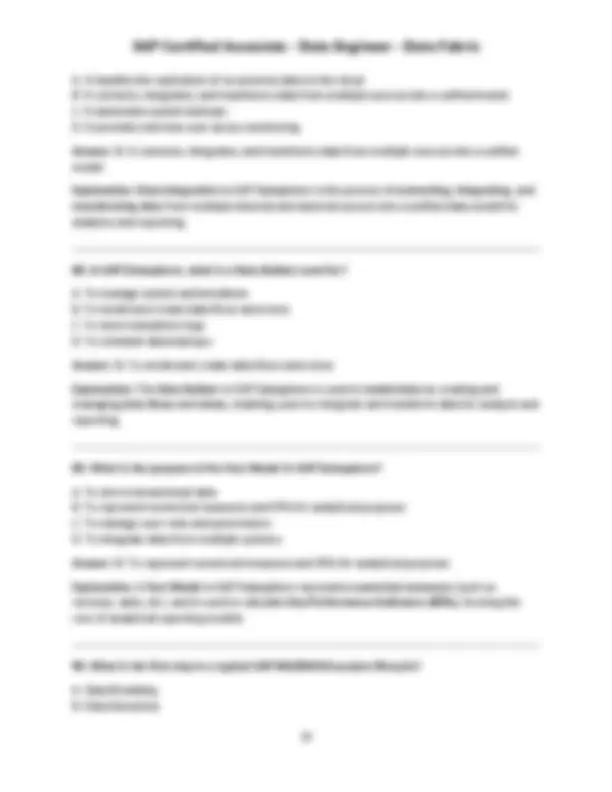
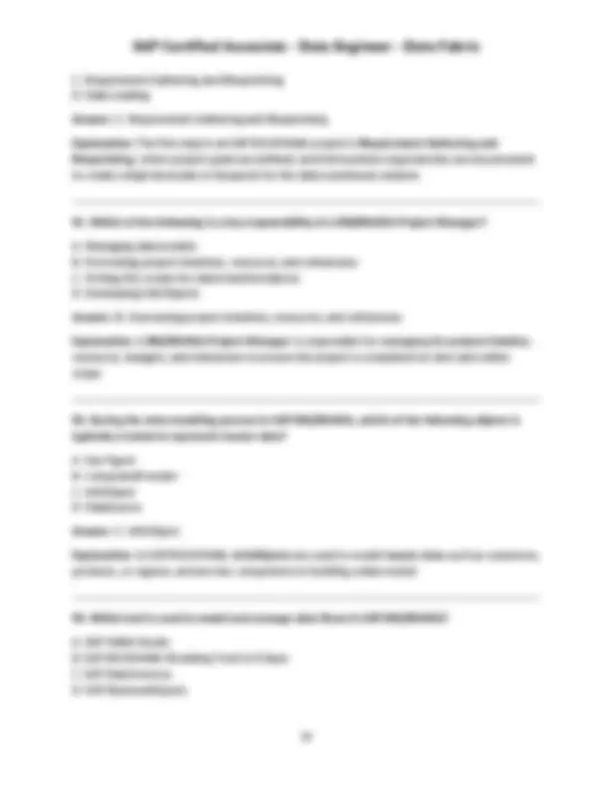
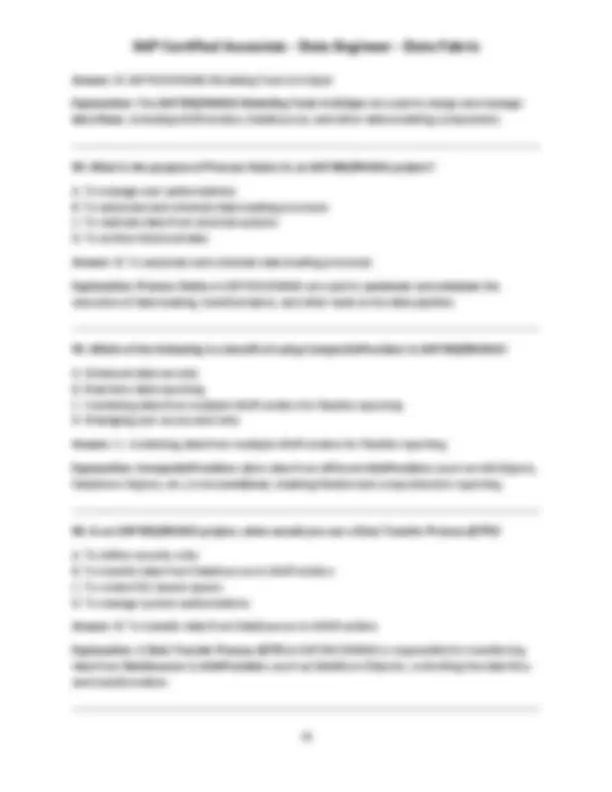
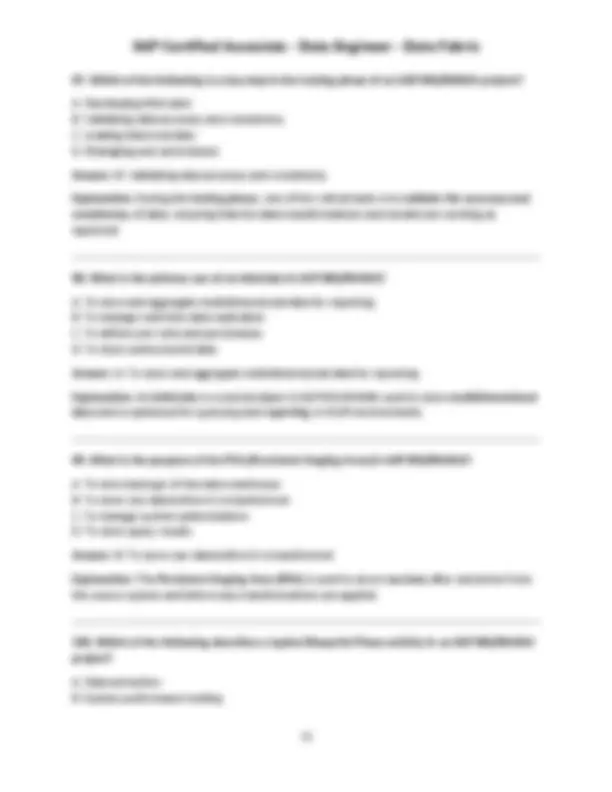
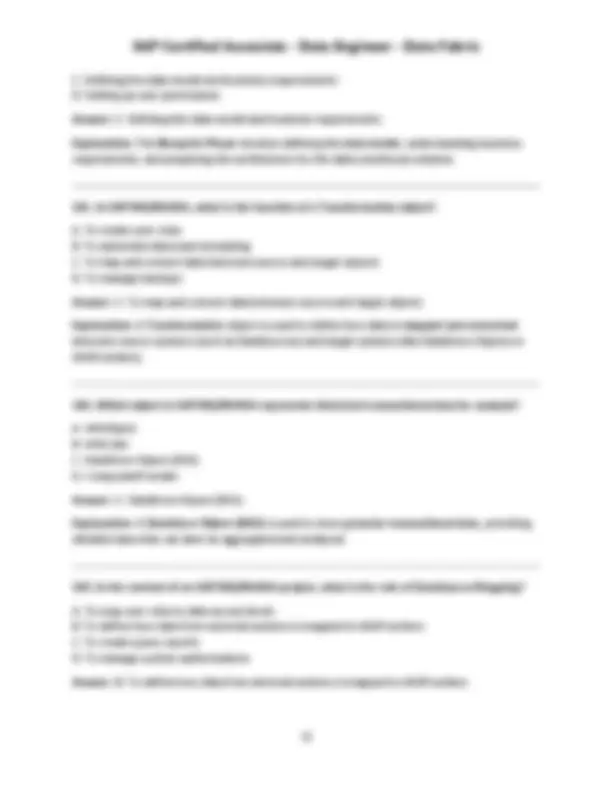
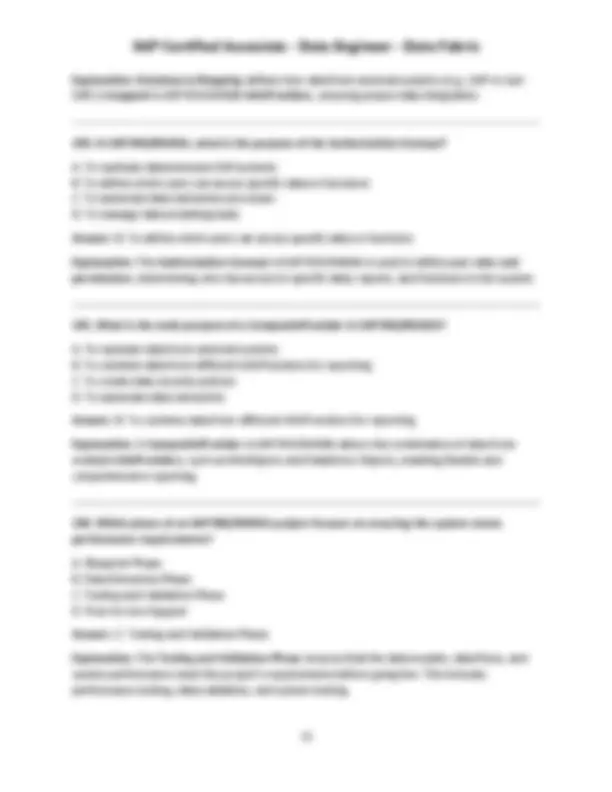
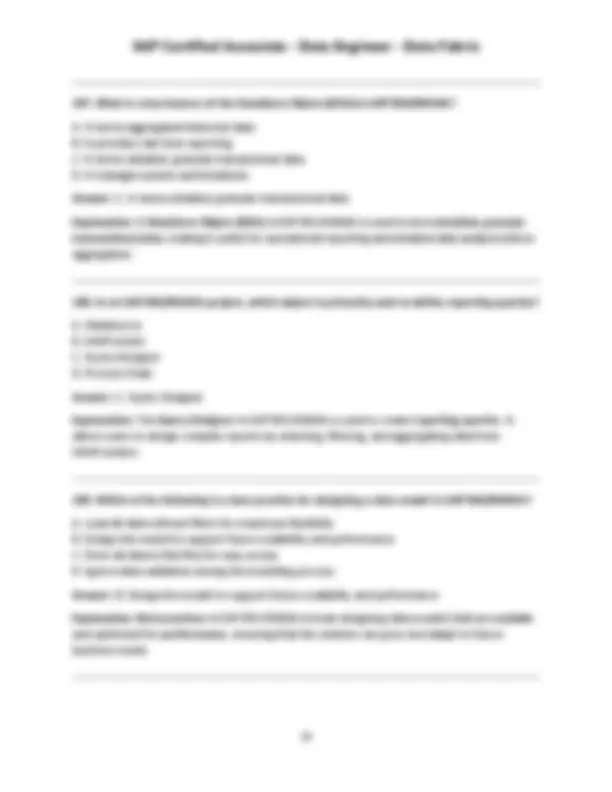
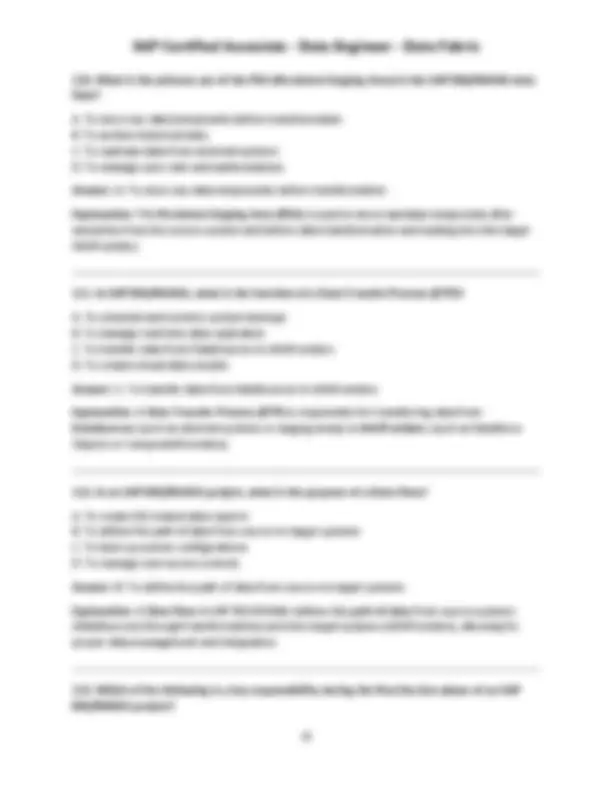
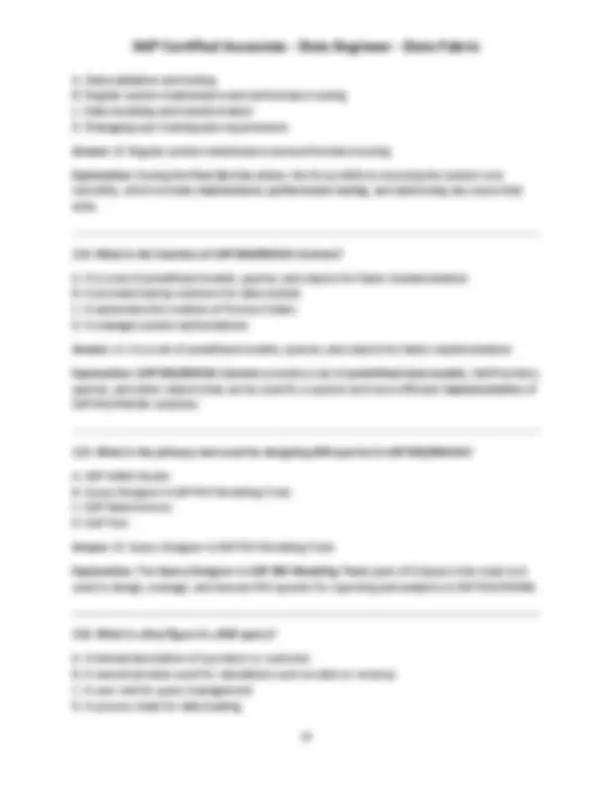
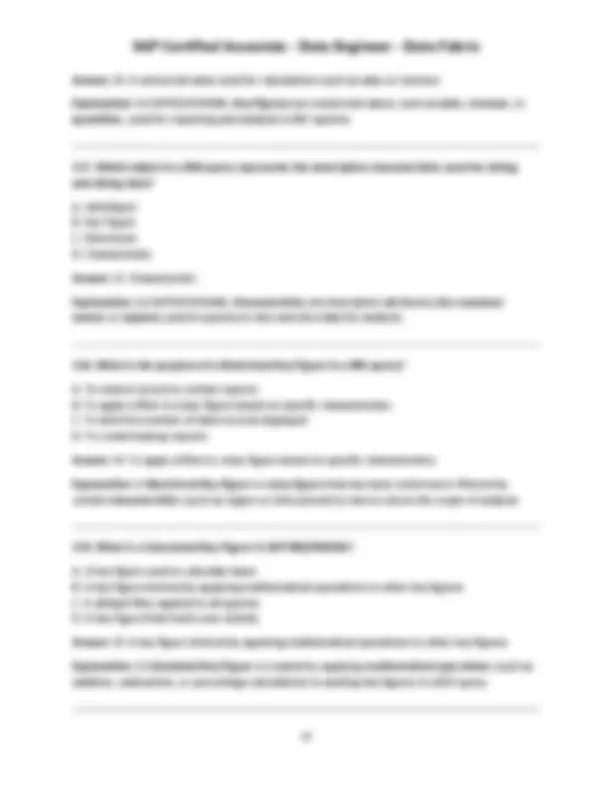
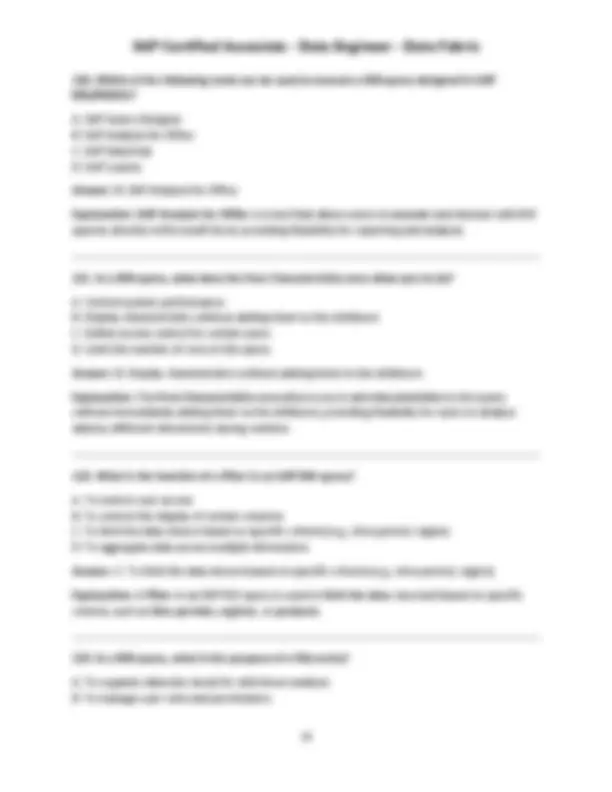
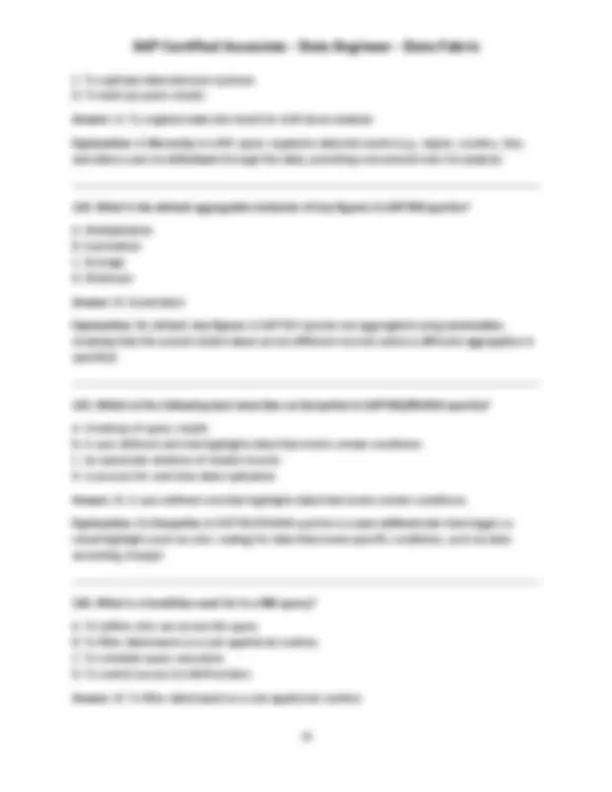
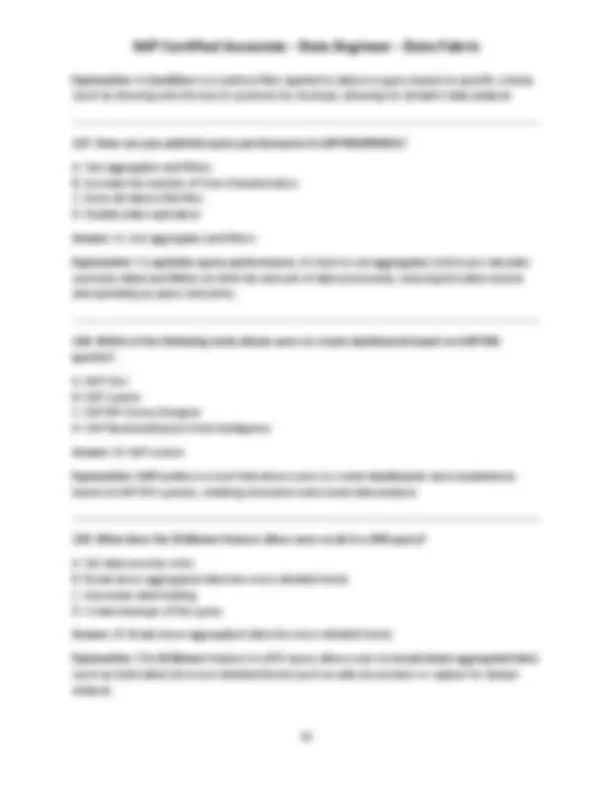
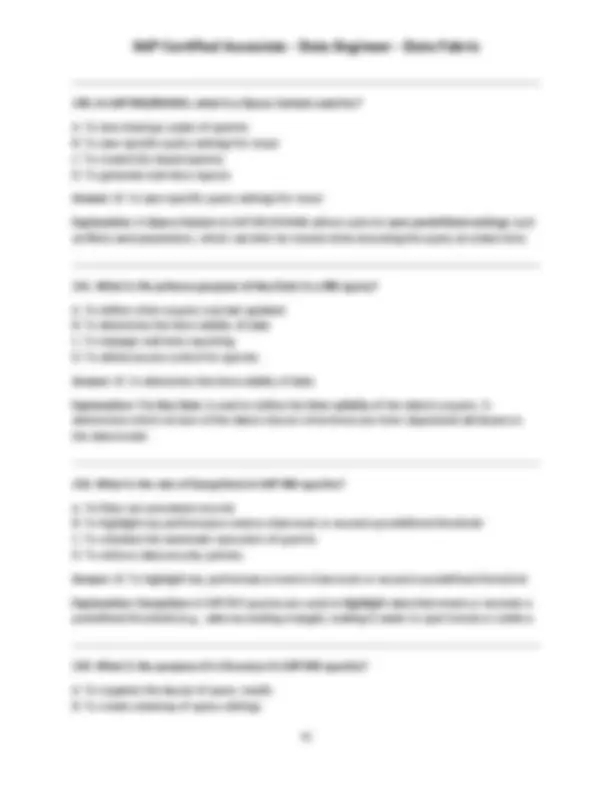
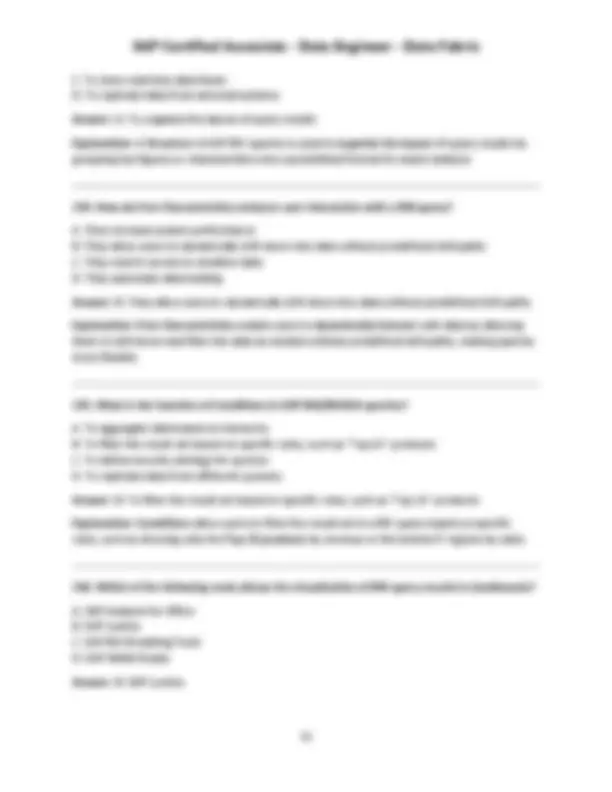
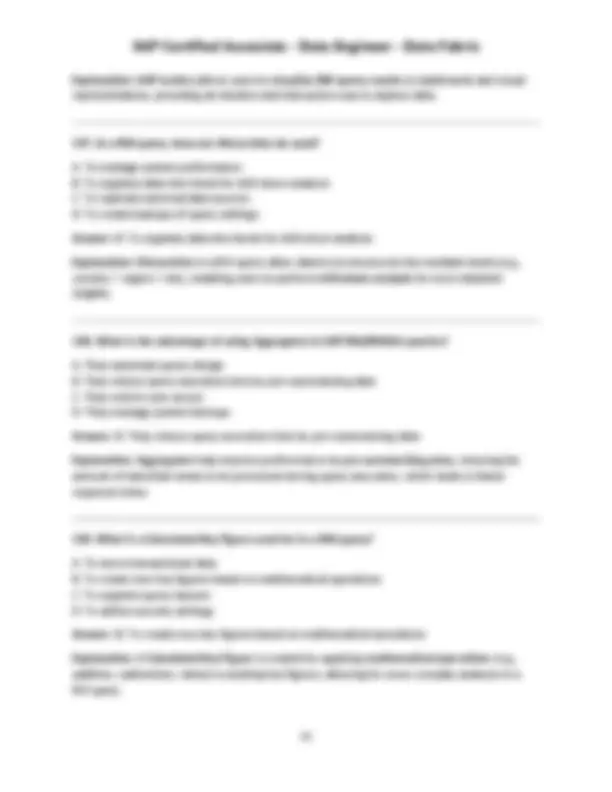
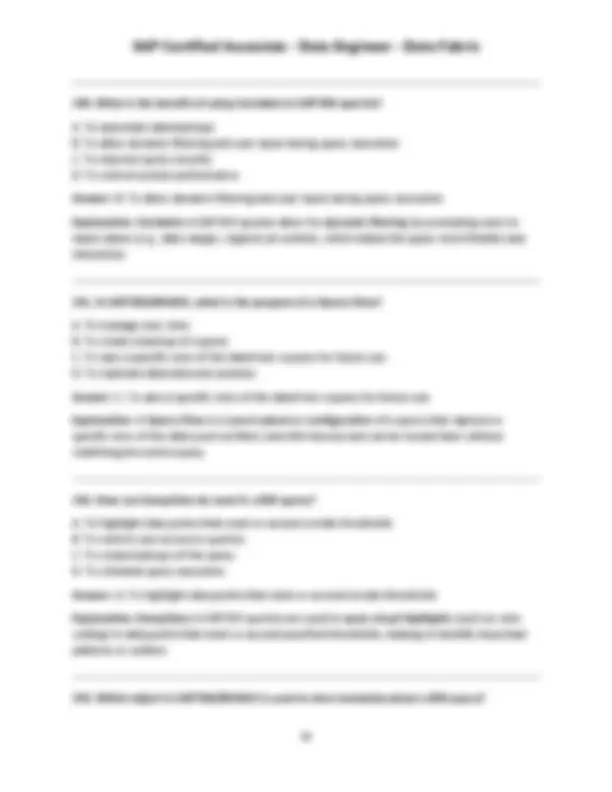
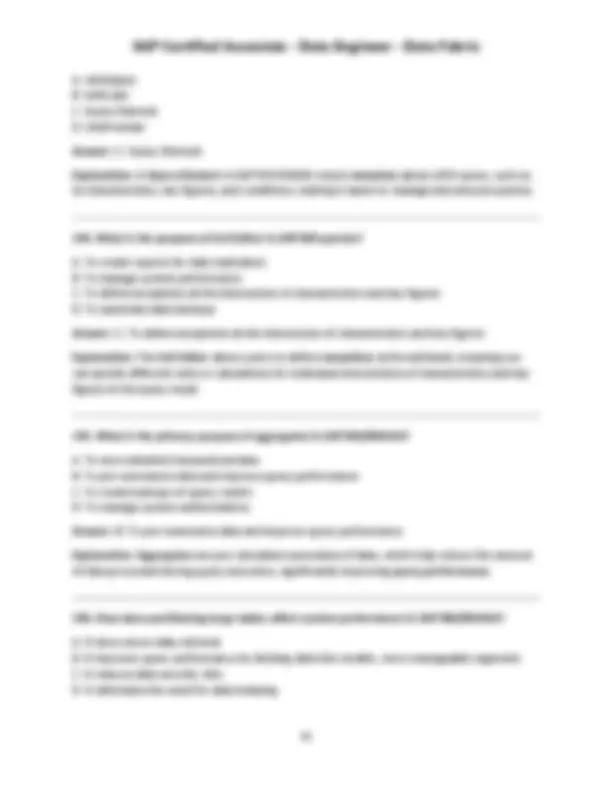
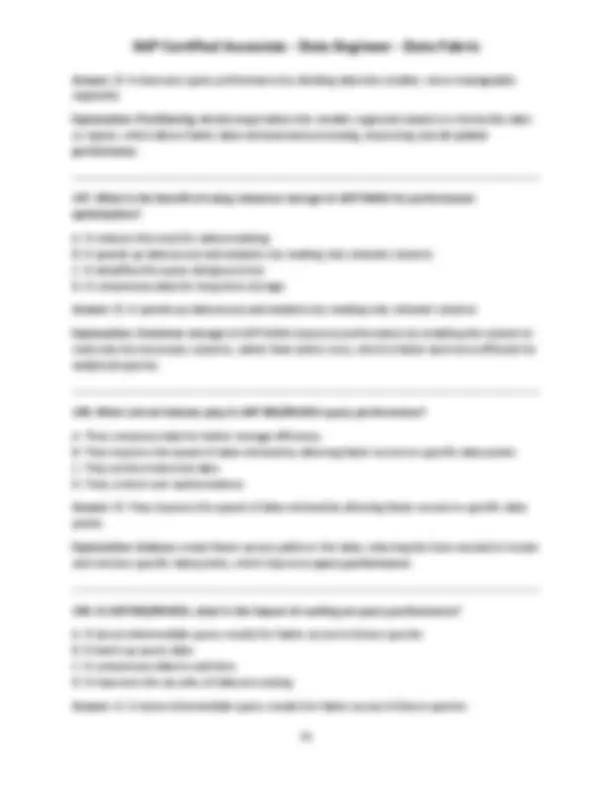
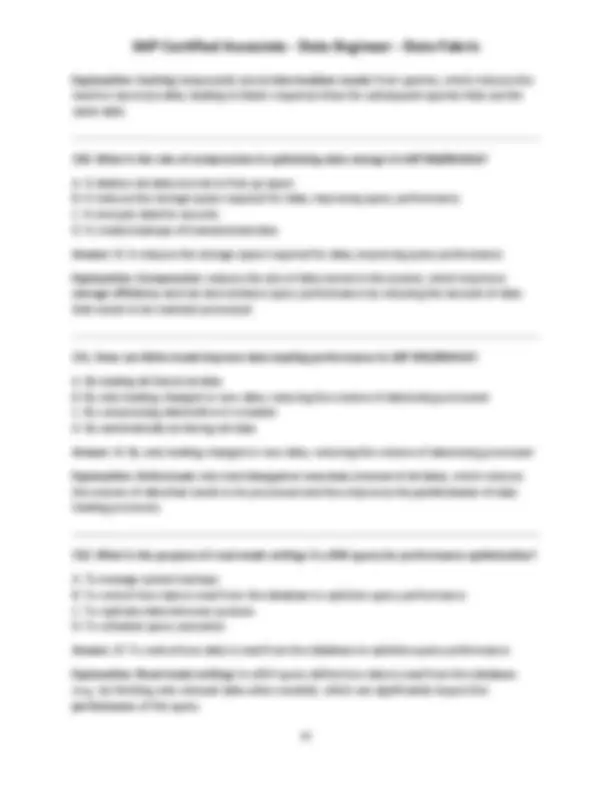
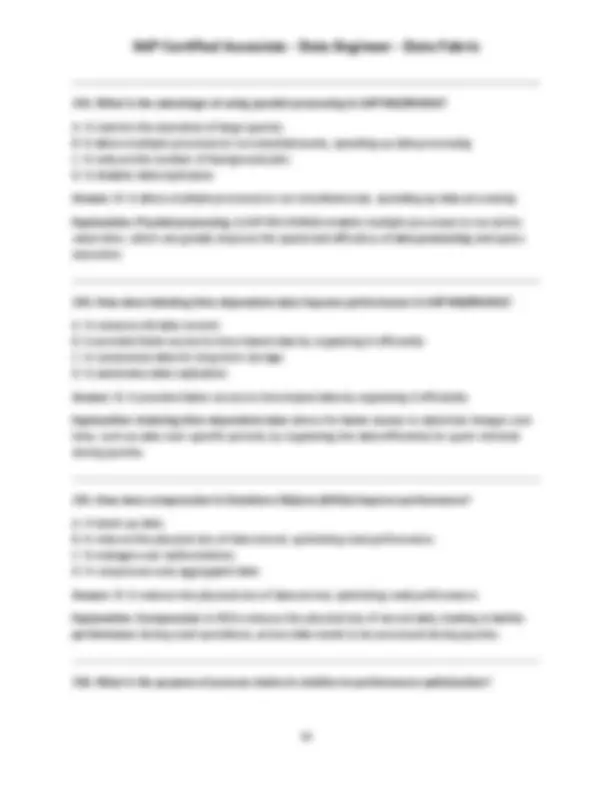
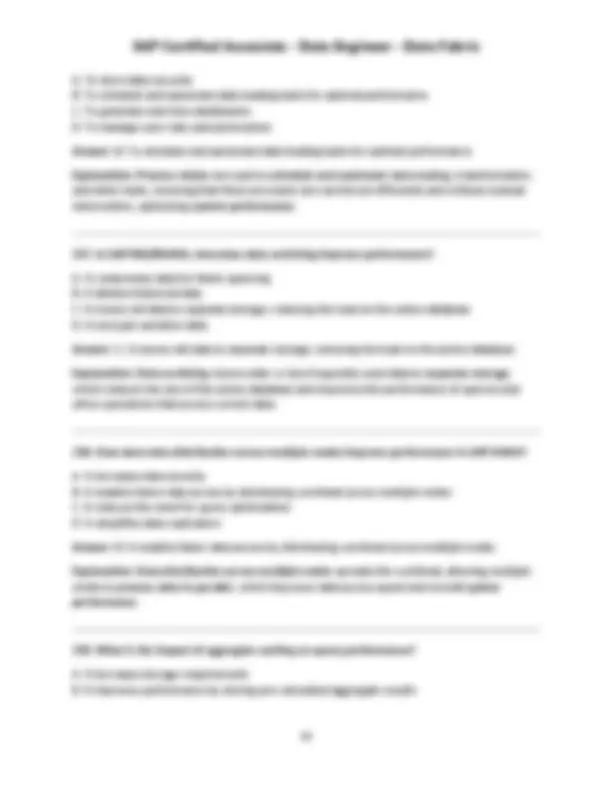
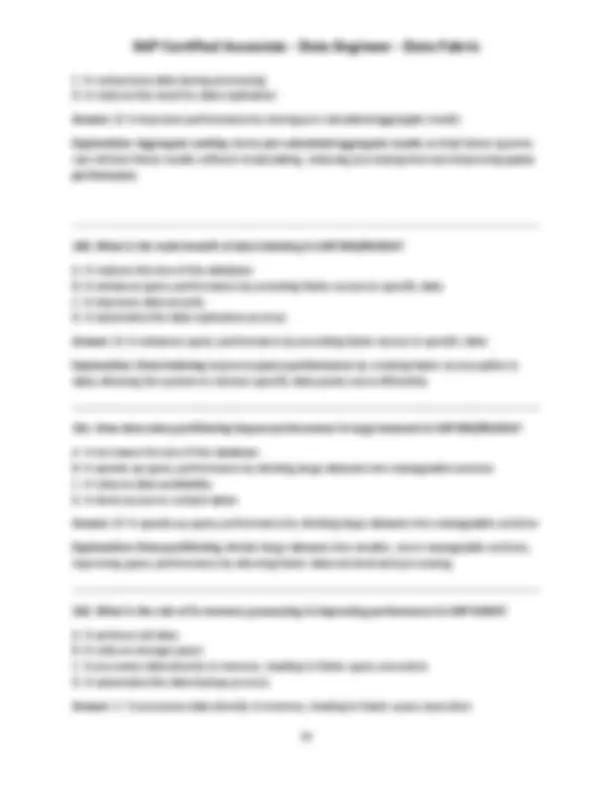

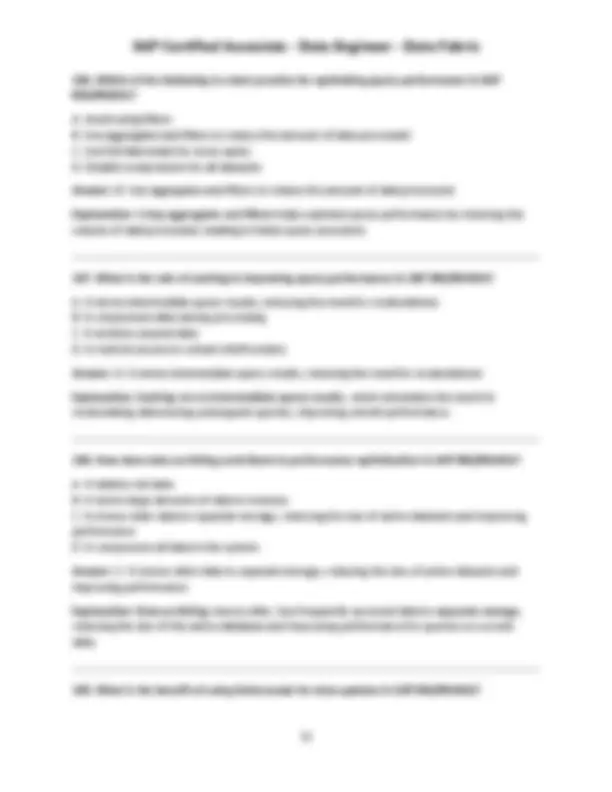
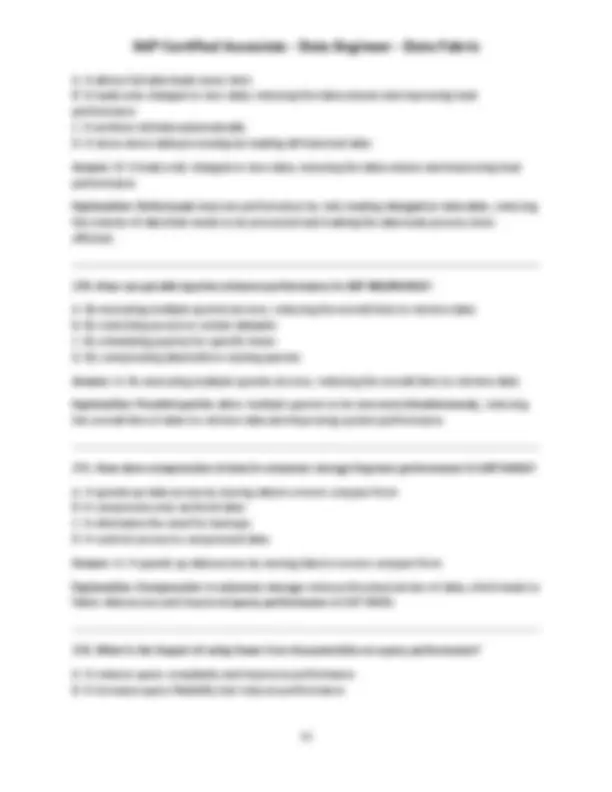
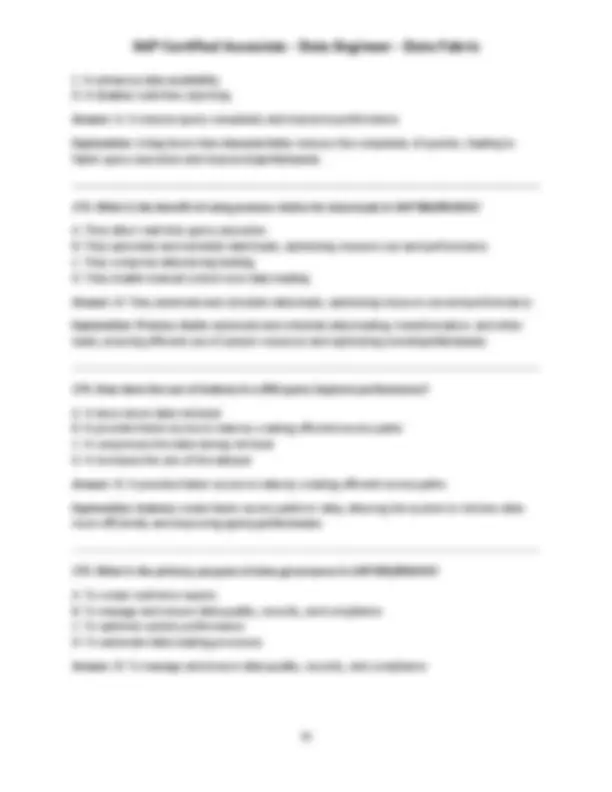
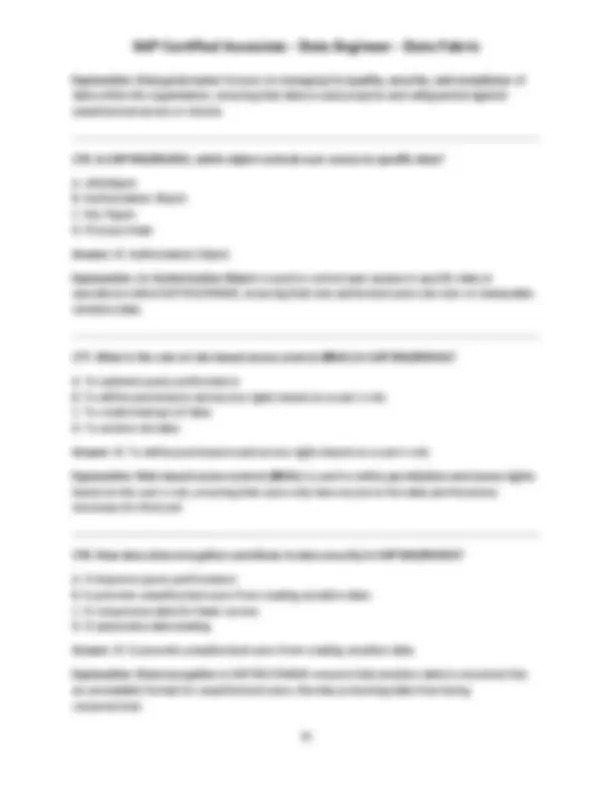
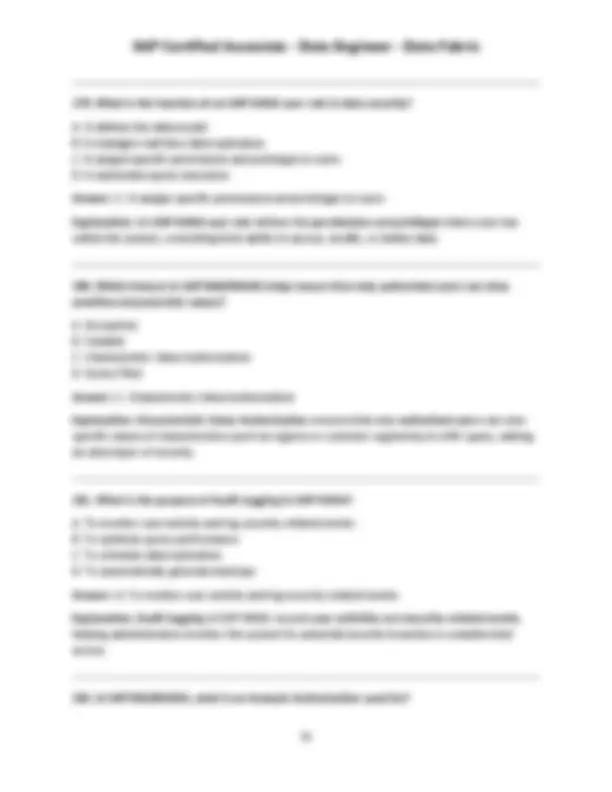
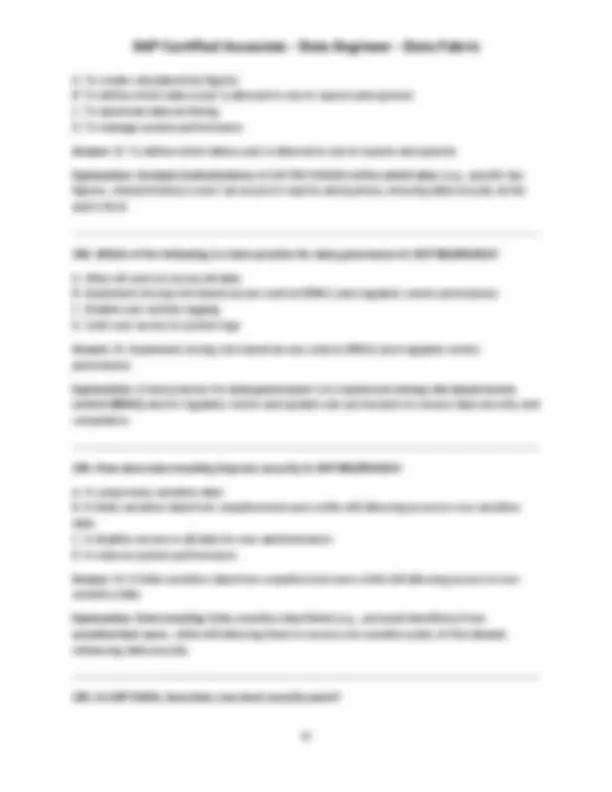

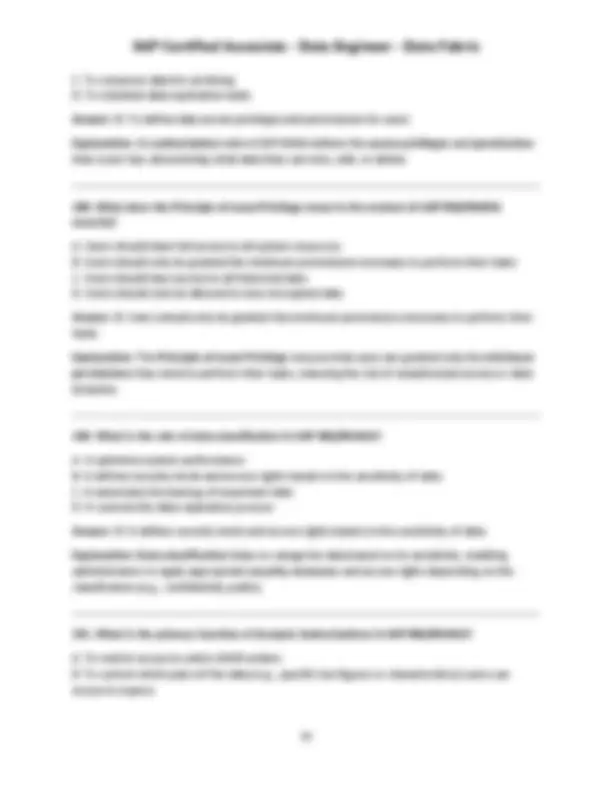
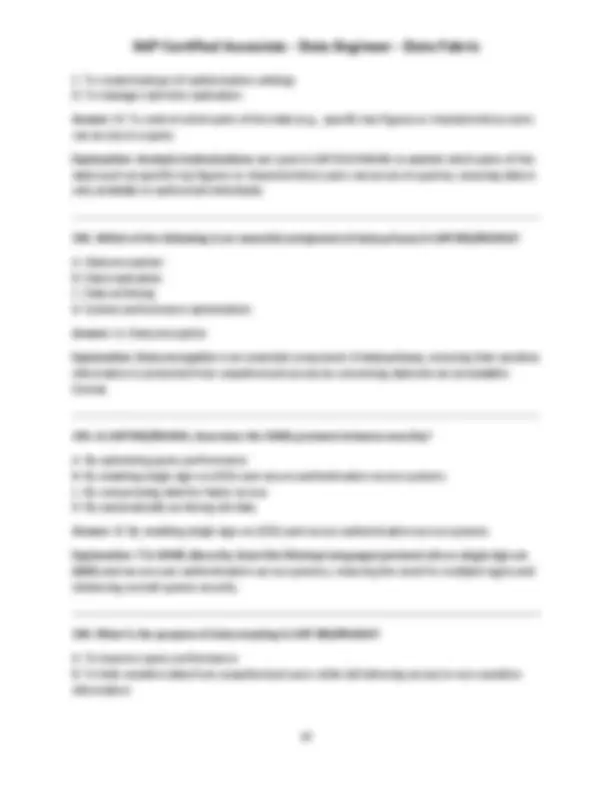


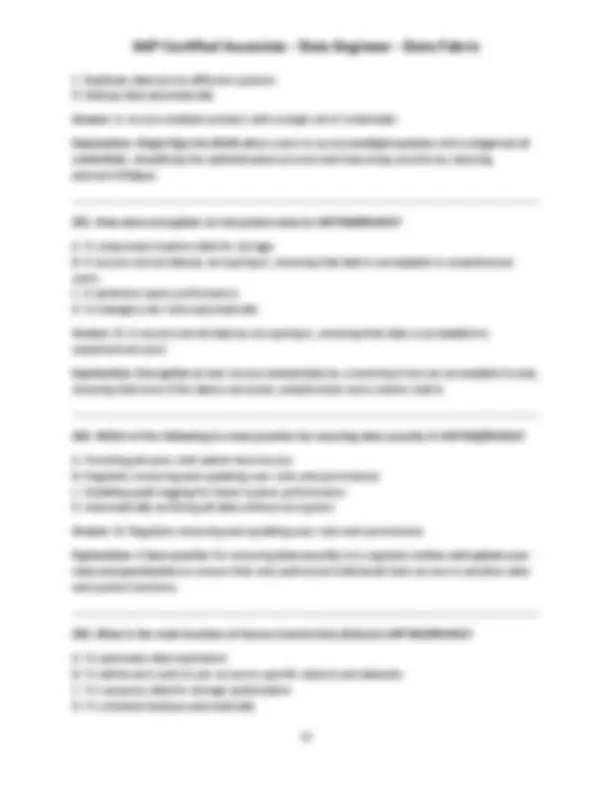



Study with the several resources on Docsity

Earn points by helping other students or get them with a premium plan


Prepare for your exams
Study with the several resources on Docsity

Earn points to download
Earn points by helping other students or get them with a premium plan
Community
Ask the community for help and clear up your study doubts
Discover the best universities in your country according to Docsity users
Free resources
Download our free guides on studying techniques, anxiety management strategies, and thesis advice from Docsity tutors
Various features and capabilities of the sap bw/4hana data fabric, which is a framework for managing and integrating data from both sap and non-sap sources. It covers topics such as open ods views for real-time data access, sap hana smart data integration for data replication and transformation, spaces for data governance and access control, the federated query engine for querying distributed data sources, and data security features like encryption, masking, and classification. Insights into how these technologies and tools can be leveraged to enable seamless data integration, real-time analytics, and enhanced data security within the sap bw/4hana ecosystem.
Typology: Quizzes
1 / 64

This page cannot be seen from the preview
Don't miss anything!

























































1. Which of the following is a key property of an InfoObject in SAP BW/4HANA? A. Data Security B. Master Data C. Virtual Tables D. Calculation Views Answer: B. Master Data Explanation: InfoObjects in SAP BW/4HANA represent the smallest building blocks of data models. They can be categorized into characteristics, key figures, units, and time characteristics. InfoObjects like characteristics can store master data which is essential for data modeling. 2. What is a CompositeProvider in SAP BW/4HANA? A. A tool for designing reports B. A data storage system C. A logical layer that combines various data sources D. An authorization control system Answer: C. A logical layer that combines various data sources Explanation: In SAP BW/4HANA, a CompositeProvider is used to combine data from different sources, such as other CompositeProviders, InfoProviders, or SAP HANA views. It enables flexible modeling and integration of data. 3. In SAP HANA HDI, what does HDI stand for? A. HANA Development Integration B. HANA Data Integration C. HANA Database Integration D. HANA Deployment Infrastructure Answer: D. HANA Deployment Infrastructure Explanation: HDI (HANA Deployment Infrastructure) is a service used to manage the lifecycle of database objects in SAP HANA. HDI allows for the structured deployment and management of database content. 4. What is the function of a Calculation View in SAP HANA?
A. Storing physical data B. Combining and transforming data for analytical purposes C. Managing database security D. Scheduling data backups Answer: B. Combining and transforming data for analytical purposes Explanation: A Calculation View in SAP HANA is used for complex data transformations and calculations. It allows users to combine multiple data sources and apply calculations, making it an essential tool for analytics.
5. Which type of InfoObject in SAP BW/4HANA is used to store quantitative data? A. Time Characteristics B. Key Figures C. Characteristics D. Units Answer: B. Key Figures Explanation: Key Figures represent quantitative data in SAP BW/4HANA, such as sales revenue, number of products sold, etc. These are typically used in reporting and analytics to quantify metrics. 6. In SAP BW/4HANA, which of the following is a primary purpose of an Open ODS View? A. To manage system authorizations B. To directly access and integrate external data sources C. To store historical data D. To create reports for end-users Answer: B. To directly access and integrate external data sources Explanation: An Open ODS View allows direct access to data from external sources, like databases or flat files, without the need for persistent storage in BW. It supports real-time access to external data for analysis. 7. What is a key characteristic of a Dimension Table in SAP BW/4HANA? A. It stores detailed transactional data B. It is used for aggregation and calculations
Explanation: DataStore Objects (DSOs) are used to store granular, detailed transactional data in SAP BW/4HANA. DSOs allow for flexible data modeling and are suitable for operational reporting.
11. What type of data does a Time Characteristic InfoObject store in SAP BW/4HANA? A. Historical data B. Temporal data such as dates and fiscal periods C. Master data for customers and products D. Currency conversion rates Answer: B. Temporal data such as dates and fiscal periods Explanation: A Time Characteristic InfoObject stores temporal data , such as dates, fiscal periods, and other time-related attributes. This is crucial for time-based analysis in BW/4HANA. 12. Which of the following is true about HDI Schemas in SAP HANA? A. They automatically store data backups B. They provide a namespace for managing database objects C. They manage user roles and permissions D. They only store unstructured data Answer: B. They provide a namespace for managing database objects Explanation: HDI Schemas provide a logical namespace for organizing and managing database objects such as tables, views, and procedures. This ensures object names do not clash between different projects. 13. What is the purpose of an Attribute View in SAP HANA? A. To model and visualize the relationships between master data B. To store user credentials C. To aggregate large datasets D. To manage data authorizations Answer: A. To model and visualize the relationships between master data Explanation: An Attribute View in SAP HANA is used to model the relationships and attributes of master data (such as customer names, product categories, etc.), and can be reused in other calculation views.
14. Which property can be defined in a Calculation View in SAP HANA HDI? A. Transactional Data Type B. Aggregation and Projection C. Data Archiving D. User Authentication Answer: B. Aggregation and Projection Explanation: In a Calculation View , you can define aggregation and projection logic, allowing for the transformation and combination of data from multiple sources, which is essential for analytic processing. 15. What is the function of InfoProviders in SAP BW/4HANA? A. Managing authorization and access control B. Storing and providing data for reporting and analysis C. Aggregating real-time data streams D. Implementing database triggers Answer: B. Storing and providing data for reporting and analysis Explanation: InfoProviders are a key component in SAP BW/4HANA and are used to store data and provide it for reporting and analysis purposes. They include objects such as CompositeProviders, InfoCubes, and DSOs. 16. Which of the following data models in SAP HANA is typically used for hierarchical data? A. Attribute View B. Calculation View C. Hierarchy View D. Analytical View Answer: B. Calculation View Explanation: In SAP HANA, Calculation Views support the modeling of hierarchies such as parent-child or level-based hierarchies, which allow you to analyze data at different levels of granularity. 17. Which of the following is a key advantage of InfoObjects in SAP BW/4HANA?
Answer: B. To design and deploy database objects Explanation: The Modeling Tool in SAP HANA HDI is used to design, develop, and deploy database objects like tables, views, and procedures. This tool is essential for building and managing data models in HANA.
21. Which of the following best describes an Analytic View in SAP HANA? A. A view that stores raw transactional data B. A view that combines transactional data with master data C. A view that creates user roles and permissions D. A view that manages database schemas Answer: B. A view that combines transactional data with master data Explanation: An Analytic View in SAP HANA is designed to combine transactional data (like sales) with master data (like products) for reporting and analysis purposes. 22. Which object in SAP BW/4HANA is used for aggregating data from different sources? A. DataStore Object (DSO) B. InfoProvider C. CompositeProvider D. Key Figure Answer: C. CompositeProvider Explanation: A CompositeProvider allows for the combination of data from multiple sources, including other InfoProviders or SAP HANA views, enabling flexible data modeling and aggregation in SAP BW/4HANA. 23. In SAP HANA HDI, which object is commonly used to define complex calculations? A. SQL Script B. Calculation View C. Attribute View D. Database Schema Answer: B. Calculation View
Explanation: A Calculation View in SAP HANA HDI is used to define complex calculations and transformations on data. It supports both simple and complex data models and is key for analytic purposes.
24. What is the purpose of a Time Dimension in a data model? A. To store user activity logs B. To categorize data based on dates and time periods C. To manage database connections D. To model complex relationships between tables Answer: B. To categorize data based on dates and time periods Explanation: A Time Dimension is used to categorize data based on dates, fiscal periods , and other time-related attributes. It is critical for time-based reporting and trend analysis. 25. In SAP BW/4HANA, which of the following allows you to logically partition data for performance improvement? A. Virtual InfoProvider B. DataSource C. Partitioning by Range D. Process Chain Answer: C. Partitioning by Range Explanation: Partitioning by Range allows for the logical partitioning of large tables in SAP BW/4HANA based on certain criteria (like date ranges), which improves query performance and data management. 26. Which of the following is a key feature of Open ODS Views in SAP BW/4HANA? A. They store unstructured data B. They allow real-time data access without replication C. They manage complex data authorizations D. They are used to generate reports directly Answer: B. They allow real-time data access without replication Explanation: Open ODS Views enable the real-time access of external data without the need for data replication into SAP BW/4HANA, allowing for direct integration and analysis of external sources.
A. A table stored in the HANA database B. A virtual table accessing external data sources C. A backup of transactional data D. A table used to manage user permissions Answer: B. A virtual table accessing external data sources Explanation: A Remote Table in SAP HANA is a virtual table that allows access to data from external systems without physically storing the data in the HANA database, making it ideal for real-time analytics.
31. Which of the following is used to define data sources in SAP BW/4HANA for acquiring data? A. InfoObjects B. DataStore Objects C. DataSources D. InfoProviders Answer: C. DataSources Explanation: In SAP BW/4HANA, DataSources are objects that define the structure and format of incoming data from external sources. They provide the blueprint for how data is extracted from source systems. 32. What is the role of an ODP (Operational Data Provisioning) in SAP BW/4HANA? A. Storing historical data B. Loading data from SAP and non-SAP sources C. Managing authorization roles D. Creating real-time dashboards Answer: B. Loading data from SAP and non-SAP sources Explanation: ODP (Operational Data Provisioning) is a framework that enables the extraction and replication of data from SAP and non-SAP systems into SAP BW/4HANA, supporting real- time data acquisition. 33. Which method is typically used to load real-time data into SAP BW/4HANA from SAP S/4HANA?
A. Flat file upload B. SAP HANA Smart Data Integration (SDI) C. Real-time ODP Extractors D. Remote DataSource connection Answer: C. Real-time ODP Extractors Explanation: Real-time ODP Extractors are commonly used to extract real-time data from SAP S/4HANA into SAP BW/4HANA, ensuring up-to-date data for analysis and reporting.
34. What is the primary function of the Process Chain in SAP BW/4HANA? A. Creating complex queries B. Scheduling and automating data load processes C. Managing system authorizations D. Defining InfoObjects Answer: B. Scheduling and automating data load processes Explanation: A Process Chain in SAP BW/4HANA is used to schedule and automate the execution of data loading and transformation processes, ensuring that data is loaded into the system at regular intervals. 35. Which of the following is true about SAP HANA Smart Data Access (SDA)? A. It allows replication of data into BW/4HANA B. It enables virtual data access without replicating data C. It performs data backups automatically D. It only works with SAP HANA databases Answer: B. It enables virtual data access without replicating data Explanation: SAP HANA Smart Data Access (SDA) allows BW/4HANA to access external data sources virtually without needing to replicate the data into the system, supporting on-demand data integration. 36. What is the purpose of the SAP HANA Smart Data Integration (SDI) tool? A. To create SQL queries B. To replicate and transform data from various sources into SAP HANA C. To manage user permissions in SAP BW/4HANA D. To visualize data in SAP Analytics Cloud
Explanation: A Transformation object in SAP BW/4HANA is responsible for mapping and converting data from a source format (e.g., DataSource) to a target format (e.g., DataStore Object), ensuring data consistency and accuracy.
40. Which tool can be used to integrate non-SAP data sources directly into SAP BW/4HANA? A. SAP BW/4HANA Modeling Tool B. SAP HANA Smart Data Integration (SDI) C. SAP Fiori D. SAP Lumira Answer: B. SAP HANA Smart Data Integration (SDI) Explanation: SAP HANA Smart Data Integration (SDI) is a tool that enables the integration of data from non-SAP sources into SAP BW/4HANA. It allows for data extraction, transformation, and loading (ETL). 41. What is the purpose of the Extraction Layer in SAP BW/4HANA? A. To store reporting queries B. To handle data loading from source systems C. To create authorization roles D. To replicate data to external systems Answer: B. To handle data loading from source systems Explanation: The Extraction Layer in SAP BW/4HANA is responsible for handling data extraction from source systems. This layer ensures that data is pulled from various sources and loaded into the staging area for further processing. 42. In the Data Acquisition Process, which of the following ensures that the data loaded into BW/4HANA is accurate and complete? A. Real-time extraction B. Data Validation Rules C. Process Chain Monitoring D. InfoObject Mapping Answer: B. Data Validation Rules
Explanation: Data Validation Rules are applied during the data acquisition process to ensure that the data loaded into BW/4HANA is both accurate and complete , meeting the required standards.
43. What is a key advantage of using ODP-based DataSources in SAP BW/4HANA? A. Automatic backup creation B. Real-time data extraction and replication C. Creating complex queries D. Managing user access Answer: B. Real-time data extraction and replication Explanation: ODP-based DataSources support real-time extraction and data replication into SAP BW/4HANA, which is essential for providing up-to-date data for analysis and reporting. 44. When integrating data into SAP BW/4HANA, which of the following describes the function of a Data Transfer Process (DTP)? A. Scheduling system backups B. Extracting data from InfoProviders C. Controlling data loading from source to target D. Generating ad-hoc reports Answer: C. Controlling data loading from source to target Explanation: A Data Transfer Process (DTP) controls the data flow from a DataSource or other providers into the target (e.g., DataStore Object). It is responsible for defining how data is transferred and processed. 45. Which of the following data integration methods is recommended for batch loading large datasets into SAP BW/4HANA? A. Real-time ODP Extractors B. Flat File DataSource C. SAP HANA Smart Data Integration (SDI) D. InfoPackage with Delta Loading Answer: D. InfoPackage with Delta Loading
49. What is the role of an InfoPackage in SAP BW/4HANA? A. To manage real-time data streaming B. To schedule and execute data loads from a DataSource C. To create custom queries for reporting D. To define user roles and authorizations Answer: B. To schedule and execute data loads from a DataSource Explanation: An InfoPackage is used in SAP BW/4HANA to schedule and execute data loads from the source system to BW, either in full or delta mode. 50. Which type of data loading does DTP (Data Transfer Process) support in SAP BW/4HANA? A. Full Load and Delta Load B. Only Full Load C. Only Delta Load D. Real-time and Full Load Answer: A. Full Load and Delta Load Explanation: The Data Transfer Process (DTP) in SAP BW/4HANA supports both Full Load (loading all data) and Delta Load (loading only changed or new data) from the source to the target system. 51. What is the function of a DataStore Object (DSO) in the context of data loading in SAP BW/4HANA? A. To manage system authorizations B. To store detailed transactional data for reporting C. To perform real-time data extraction D. To back up data from external systems Answer: B. To store detailed transactional data for reporting Explanation: A DataStore Object (DSO) stores granular transactional data and serves as a staging area for data before it is aggregated and loaded into higher-level InfoProviders for reporting. 52. Which of the following is a key feature of SAP HANA Smart Data Integration (SDI)?
A. It provides real-time, virtual access to external systems B. It performs data replication and transformation from multiple sources C. It allows for real-time report generation D. It manages user access and authorizations Answer: B. It performs data replication and transformation from multiple sources Explanation: SAP HANA Smart Data Integration (SDI) is used to replicate and transform data from multiple sources into SAP HANA, allowing seamless integration of SAP and non-SAP data sources.
53. What is a Direct Access DataSource used for in SAP BW/4HANA? A. To retrieve data from SAP HANA without storing it in BW B. To create real-time dashboards C. To schedule data loading D. To replicate external data sources Answer: A. To retrieve data from SAP HANA without storing it in BW Explanation: A Direct Access DataSource allows for on-demand retrieval of data from SAP HANA or external systems without physically storing it in SAP BW/4HANA. This is useful for virtual access to real-time data. 54. What is the benefit of using Delta Queue in SAP BW/4HANA? A. It ensures data loads are always performed in full mode B. It handles multiple data loads at the same time C. It keeps track of changes in data for efficient delta loading D. It manages system authorizations during data transfer Answer: C. It keeps track of changes in data for efficient delta loading Explanation: The Delta Queue ensures that only the changes (delta) in the data are captured, which reduces the data volume and makes the data load process more efficient. 55. In SAP BW/4HANA, what is the function of the PSA (Persistent Staging Area)? A. It stores data temporarily before it is transformed B. It creates virtual tables for real-time access C. It manages user authentication D. It schedules data backups
Explanation: A Process Chain is used to monitor , schedule , and manage the status of data loading processes in SAP BW/4HANA, ensuring data is loaded and transformed according to defined schedules.
59. What is the primary function of the Source System object in SAP BW/4HANA? A. To create complex reports B. To define the connection to the external data source C. To aggregate data for reporting D. To schedule delta data loads Answer: B. To define the connection to the external data source Explanation: The Source System object in SAP BW/4HANA defines the connection to the external system from which data is extracted. This can include SAP systems, databases, or flat files. 60. Which of the following data loading scenarios is typically used for external non-SAP sources? A. InfoPackage and Delta Queue B. Flat File Upload C. SAP HANA Smart Data Integration (SDI) D. Virtual Data Access Answer: C. SAP HANA Smart Data Integration (SDI) Explanation: SAP HANA Smart Data Integration (SDI) is a powerful tool used to load and transform data from external non-SAP sources into SAP BW/4HANA, providing a seamless ETL (Extract, Transform, Load) process. 61. What is the primary purpose of SAP Datasphere? A. To store master data B. To create and manage data integration pipelines C. To replicate data between on-premise and cloud systems D. To unify and harmonize data across diverse sources for seamless analytics Answer: D. To unify and harmonize data across diverse sources for seamless analytics
Explanation: SAP Datasphere is designed to provide a unified and harmonized data layer across various systems, allowing for seamless integration, modeling, and analytics from multiple data sources, both cloud and on-premise.
62. Which of the following is a key benefit of using SAP BW bridge within SAP Datasphere? A. Automated data archiving B. Real-time data replication without transformation C. Seamless integration of existing SAP BW/4HANA models into SAP Datasphere D. Data encryption for secure data transfer Answer: C. Seamless integration of existing SAP BW/4HANA models into SAP Datasphere Explanation: SAP BW bridge allows for the seamless integration of existing SAP BW/4HANA models into SAP Datasphere, ensuring businesses can leverage their existing data models and logic in a cloud environment. 63. What is a Business Entity in SAP Datasphere? A. A type of data replication tool B. A modeling object that represents real-world objects or concepts C. A data backup feature D. A security protocol for data encryption Answer: B. A modeling object that represents real-world objects or concepts Explanation: In SAP Datasphere, a Business Entity is a modeling object used to represent real- world objects (such as products, customers, or transactions) and is central to creating meaningful data models. 64. Which of the following is a feature of Spaces in SAP Datasphere? A. To control data access and governance for specific teams B. To create backups of the data models C. To automate data archiving D. To manage system performance Answer: A. To control data access and governance for specific teams Explanation: Spaces in SAP Datasphere provide a mechanism to organize data , control access , and governance for different teams or departments, enabling more flexible and secure data management.